稀有金属 2012,36(04),676-680
氧化铝赤泥盐酸浸出稀土元素研究
王克勤 宋嘉伟 高燕 姜武
太原理工大学材料科学与工程学院
摘 要:
在用盐酸浸出氧化铝赤泥提取氧化钪的过程中,稀土元素镧,铈,钕也一同浸出,进入到浸出液中。研究了拜耳法赤泥盐酸浸出稀土元素镧,铈,钕的过程。研究了浸出温度、酸度、液固比和浸出时间对稀土元素浸出率的影响。研究结果表明,影响稀土浸出率的因素依次是浸出温度,盐酸浓度,配料液固比,和浸出时间。当接近沸点109℃浸出时,镧、铈、钕浸出率提高最快。盐酸酸度在4~5 mol.L-1时,浸出率升高较快,5~7 mol.L-1时,缓慢提高,当超过7 mol.L-1时,镧、铈、钕的浸出率基本不变化。当液固比为4.0时,镧、铈、钕元素的浸出率较低,仅为60%~75%之间,当液固比提高到5.0时,稀土元素的浸出率升高较快。随着浸出时间的延长,氧化稀土的浸出率从60~180 min时,缓慢提高,在180 min时达到最大值,超过180 min后,变化不大。在温度为沸点(109℃),液固比6.0,时间180 min。盐酸浓度7 mol.L-1的条件下浸出,赤泥中La,Ce,Nd的浸出率能达到95%以上。
关键词:
拜耳法赤泥;浸出;液固比;
中图分类号: TF821
作者简介:王克勤(1956-),男,河北唐山人,学士,副教授;研究方向:有色金属冶金(E-mail:wk6591@163.com);
收稿日期:2012-01-05
基金:山西省科技攻关项目(2010-28)资助;
Leaching Rare Earth Elements from Alumina Red Mud Hydrochloric Acid
Abstract:
In the process of extracting scandium oxide from alumina oxide red mud using hydrochloric acid leaching,it was found that rare earth elements,such as La,Ce,and Nd also entered the leaching solution.The Bayer process for red mud hydrochloric acid leaching rare earth elements,lanthanum,cerium,and neodymium process was studied.The leaching temperature,acidity,the liquid-solid ratio and leaching time leaching rate of rare earth elements of influence were studied.The results showed that,the influence factors of rare earth leaching rate in turn was leaching temperature,hydrochloric acid concentration,the liquid-solid ratio,and leaching time.When close to boiling point 109 ℃,lanthanum,cerium,and neodymium leaching rate increased the fastest.Hydrochloric acid in 45 mol · L-1,leaching rate increased quickly,57 mol · L-1,rose gradually,when more than 7 mol · L-1,lanthanum,cerium,and neodymium leaching rate of basic did not change.When the liquid-solid ratio of 4.0,lanthanum,cerium,and neodymium element extraction rate was low,only 60% 75% between,when the liquid-solid ratio increased to 5.0,rare earth elements extraction rate increased quickly.As the extension of leaching time,from 60 to 180 min,the rare earth oxide leaching rate slowly increased,in 180 min to achieve maximum.As to leaching time of more than 180 min,there was only a little change.In the temperature of boiling point(109 ℃),the liquid-solid ratio 6.0,time 180 min hydrochloric acid concentration 7 mol · L-1,under the leaching conditions,La,Ce,Nd in red mud extraction rate could reach more than 95%.
Keyword:
Bayer process red mud;leaching;liquid-solid rate;
Received: 2012-01-05
氧化铝赤泥是氧化铝生产过程中的废弃物。赤泥为碱性物质,易碱化土地,污染地下水,严重危害人们健康[1]。由于各地铝土矿的差异和氧化铝生产工艺的不同,赤泥的化学组成差异很大[2]。氧化铝赤泥中含有稀有金属、稀土金属及铝、铁等有价成分[3],是一种非常有价值的二次资源。在盐酸浸出提取回收氧化钪[4]的同时,镧、铈、钕等稀土元素一起被浸出[5],进入到盐酸浸出液中,本试验将镧、铈、钕稀土元素一起回收利用。
表1 赤泥的化学成分(%)Table 1 Chemical composition of red mud(%) 下载原图

表1 赤泥的化学成分(%)Table 1 Chemical composition of red mud(%)
表2 赤泥中稀土元素含量(%)Table 2 Rare earth elements content of red mud(%) 下载原图

表2 赤泥中稀土元素含量(%)Table 2 Rare earth elements content of red mud(%)
1 实验
1.1 原料
样品取自山西某拜耳法氧化铝厂,放置时间均为30 d。化学成分见表1,均以氧化物表示。
测定方法:准确称量105~110℃下烘干样品0.2500 g,置于银坩埚中,滴无水乙醇润湿,再加氢氧化钾,置于750℃坩埚炉中熔融20 min,取出,然后将坩埚中的固体全部用6 mol·L-1盐酸溶液溶解到容量瓶中,定容,待测[6]。
以上成分均以金属氧化物表示,化学成分测定方法:氧化钙、氧化铝、氧化铁为容量法,氧化钠为火焰光度法;氧化硅为钼蓝分光光度法[6]、其余为分光光度法[7]和ICP-MS方法。
1.2 实验方法
将烘干后的氧化铝赤泥放入圆底三口烧瓶中,加回流装置,电动搅拌,加入盐酸搅拌浸出[8]。浸出液固比;浸出时间;浸出温度;盐酸浓度[9]采用正交设计,试验采用4因素5水平正交设计[10],见表3。本文主要考察氧化镧、氧化铈、氧化钕的浸出效果。
1.3 实验原理
由于赤泥中的稀土元素呈分散态赋存在赤泥中[11],在高p H值,即强碱状态下,使稀土离子定量地转变成稀土氢氧化物,脱水后便生成稀土氧化物凝胶,干燥后,变成氧化物分散在赤泥中[12],国内的专家对赤泥中的Sc和RE的物相做了大量的研究表明[13],赤泥中的Sc和RE不是离子吸附型,也不存在于新形成的铝硅酸盐矿物相中,主要以类质同象形式分散于铝土矿及其副矿物,如金红石、钙钛矿、各新生矿物中[14],钙钛矿中稀土含量较高[15,16],赤泥中钙钛矿的X射线能谱分析结果见表4,钙钛矿的能谱图见图1。
2 结果与讨论
试验结果见表5,考察浸出液中氧化镧、氧化铈、氧化钕浓度及浸出率。
表3 试验设计Table 3 Experimental design 下载原图
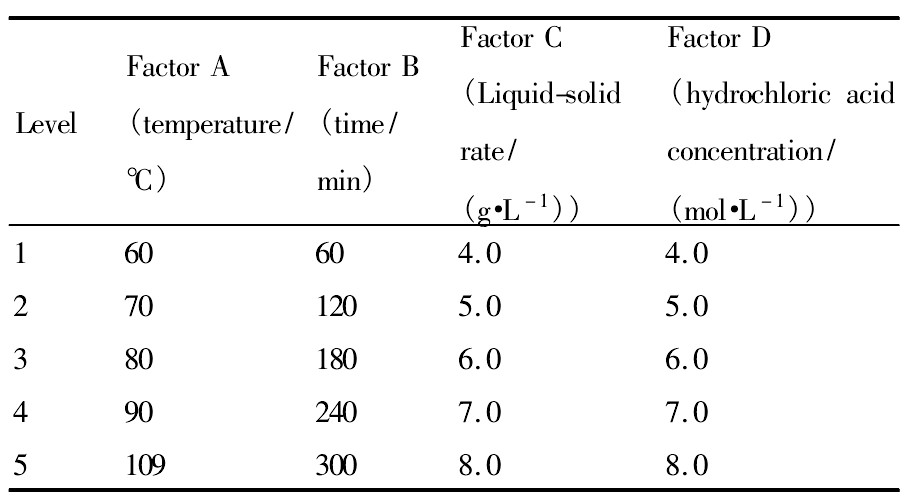
表3 试验设计Table 3 Experimental design
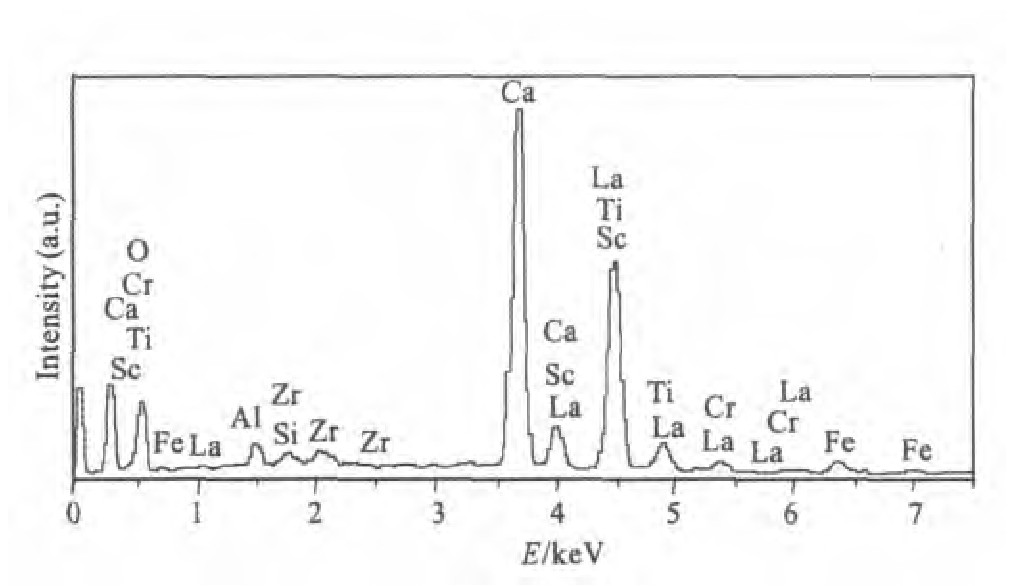
图1 钙钛矿的能谱图Fig.1 EDS analysis results of perovskite
表4 钙钛矿的X射线能谱分析(%)Table 4 EDS analysis results of perovskite(%) 下载原图

表4 钙钛矿的X射线能谱分析(%)Table 4 EDS analysis results of perovskite(%)
2.1 浸出温度对稀土元素浸出率的影响
随浸出温度升高,赤泥中稀土元素的浸出率随之升高,当加热到沸点时,浸出率进一步升高,氧化镧,氧化铈,氧化钕的浸出率随温度升高的变化见图2~4。氧化镧在60~70℃之间时,镧的浸出率基本不变;当温度升高到80℃时,镧的浸出率上升较快,当接近沸点时浸出率提高最快。铈、钕的浸出率随温度升高缓慢提高,当接近沸点109℃浸出时,浸出率提高最快。镧、铈、钕浸出率随浸出温度的变化规律基本相同。
2.2 浸出时间对稀土元素浸出率的影响
氧化镧,氧化铈,氧化钕的浸出率随温度升高的变化见图2~4。随着浸出时间的延长,氧化钪的浸出率从60~180 min时,缓慢提高,在180 min时达到最大值,超过180 min后,变化不大。镧、铈、钕浸出率随浸出时间的变化规律基本相同。
2.3 浸出液固比对稀土元素浸出率的影响
液固比对稀土浸出率影响很大,当液固比为4.0时,镧、铈、钕元素的浸出率较低,仅为60%~75%之间,当液固比提高到5.0时,稀土元素的浸出率升高较快。由于赤泥为强碱性固体,并且含有铝、铁、钙等元素,要消耗大量的盐酸,当液固比为4.0时,溶液中的游离盐酸的浓度降低,稀土元素的溶出率很难再有提高。酸耗主要包括两方面,主要是化学反应损失,二是物理挥发损失[17],由于加装了回流装置,在沸点(109℃)时物理挥发损失较少。但如果再将配料液固比提高,盐酸的回收成本将大幅度的升高,经济上不合算。
表5 浸出液稀土元素浓度和浸出率Table 5 Leaching solution concentration and leaching rate of rare earth elements 下载原图
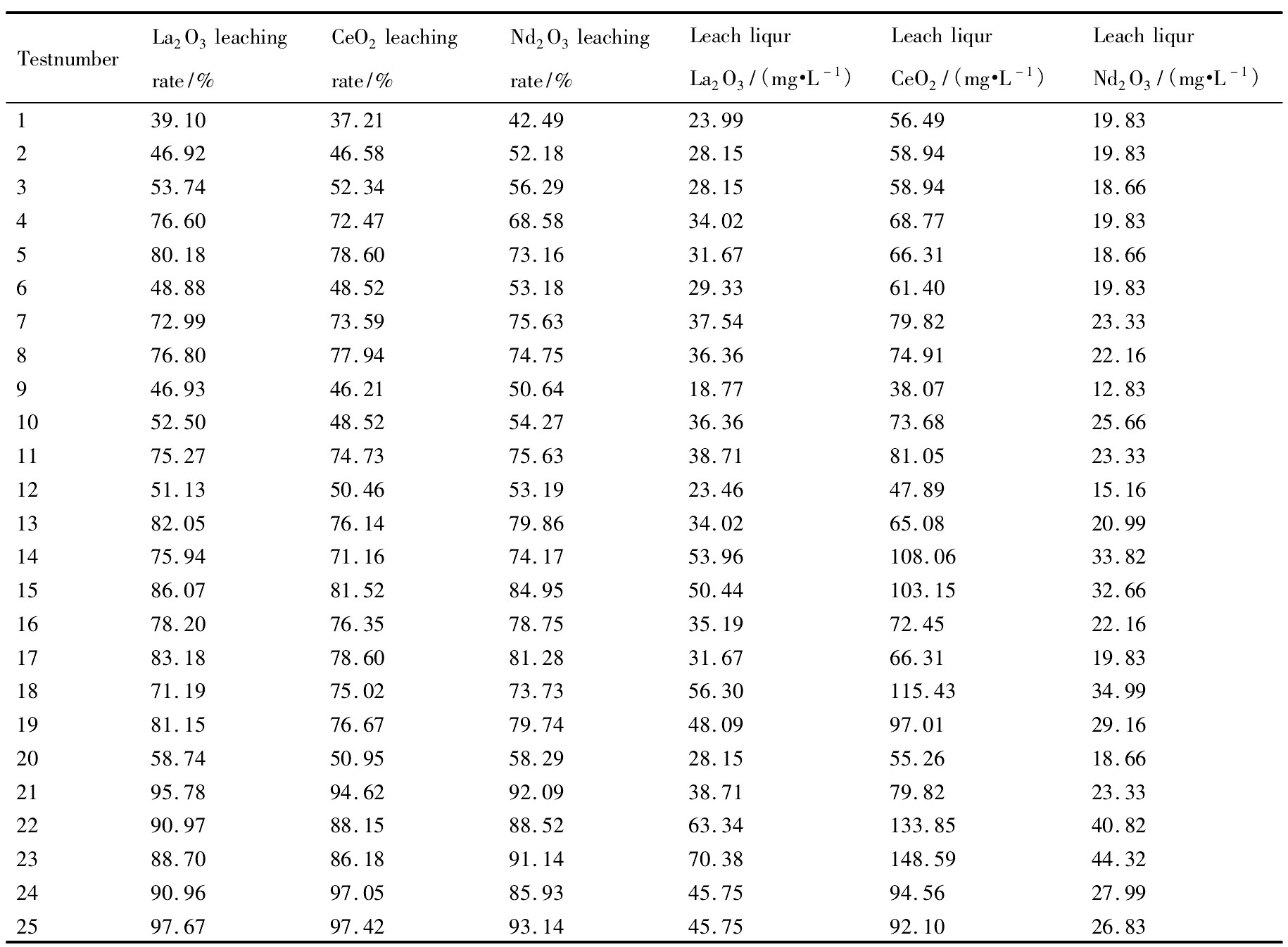
表5 浸出液稀土元素浓度和浸出率Table 5 Leaching solution concentration and leaching rate of rare earth elements
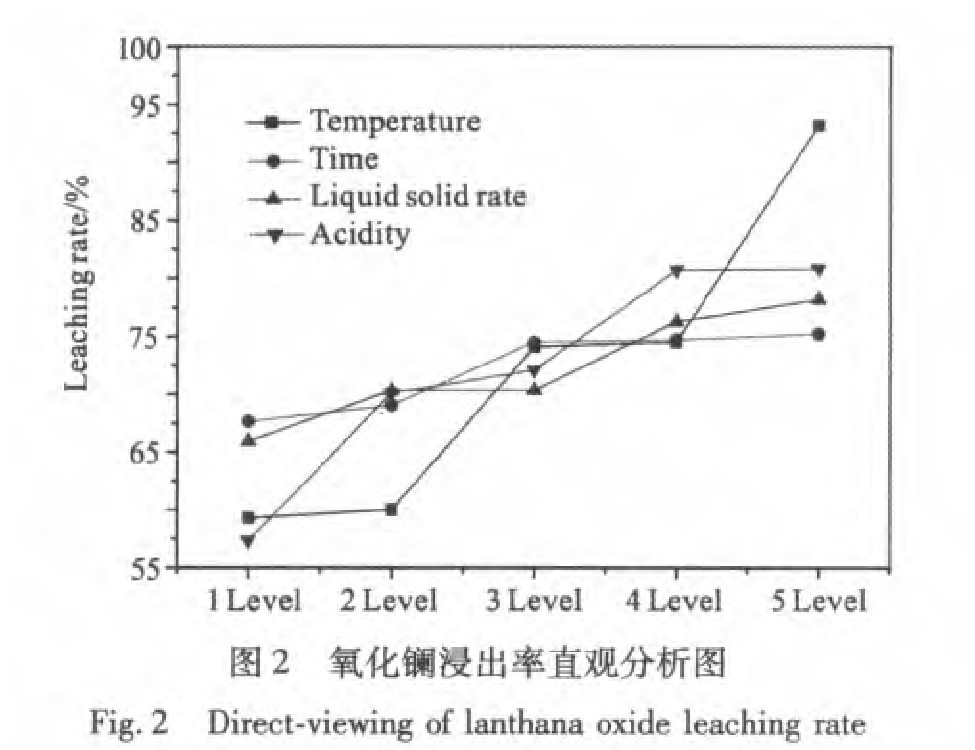
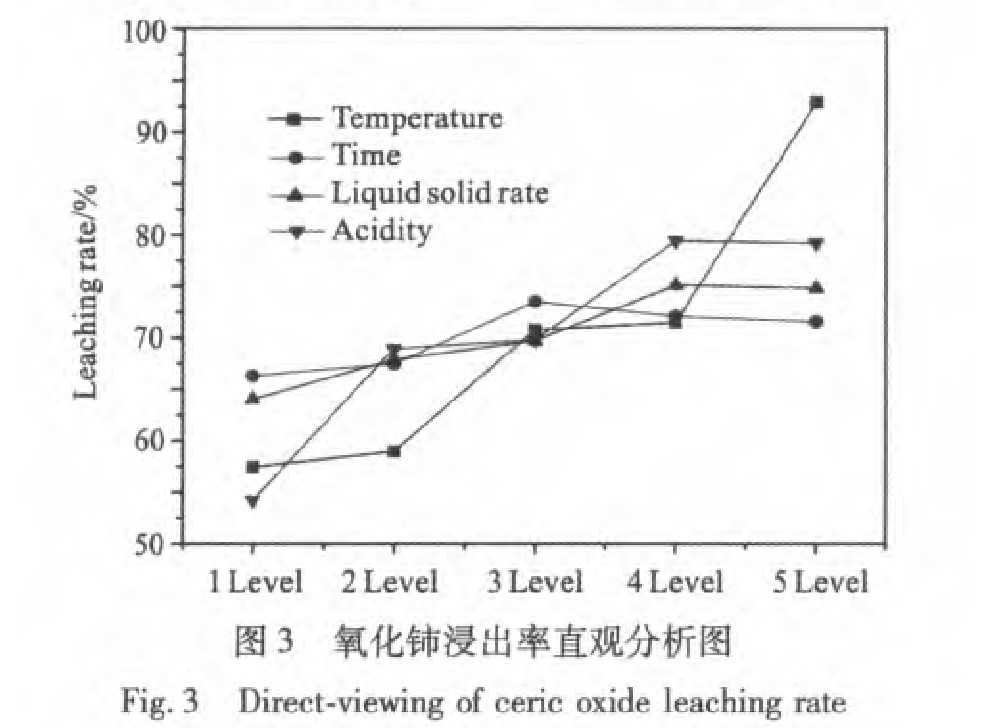
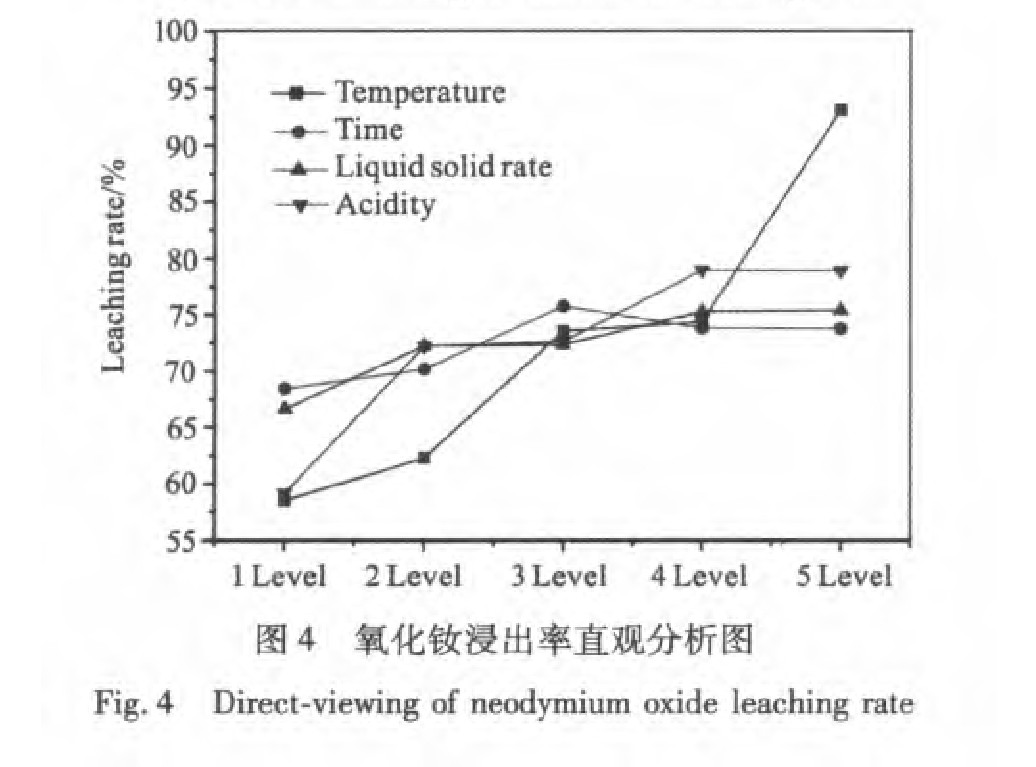
2.4 盐酸浓度对稀土元素浸出率的影响
盐酸酸度在4~5 mol·L-1时,浸出率升高较快,5~7mol·L-1时,缓慢提高,当超过7 mol·L-1时,镧、铈、钕的浸出率基本不变化,再提高酸度没有意义。
2.5 最优条件下的浸出实验结果
根据正交试验结果,在浸出温度为沸点(109℃),浸出时间为180 min,液固比为6.0,盐酸浓度为7 mol·L-1的条件下做了浸出试验,浸出液浓度、浸出率结果见表6。
表6 浸出液浓度及浸出率Table 6 Leaching solution concentration and leaching rate 下载原图

表6 浸出液浓度及浸出率Table 6 Leaching solution concentration and leaching rate
3 结论
在本实验条件下,用盐酸浸出赤泥中的稀土元素,影响稀土浸出率的因素依次是浸出温度,盐酸浓度,配料液固比和浸出时间。盐酸酸度在4~5 mol·L-1时,浸出率升高较快,5~7 mol·L-1时,缓慢提高。当超过7 mol·L-1时,镧、铈、钕的浸出率基本不变化在温度为沸点(109℃),液固比6.0,时间180 min。盐酸浓度7 mol·L-1的条件下浸出,赤泥中La,Ce,Nd的浸出率能达到95%以上。
参考文献
[1] Cao L J,Li J Q,Xun B J.Research on lixiviating red mud with hydrochloric acid for enrichment titanium[J].Journal of the Chinese Society of Rare Earths,2008,26(8):819.(曹利军,李军旗,徐本军.赤泥盐酸浸出富集钛的实验研究[J].中国稀土学报,2008,26(8):819.)
[2] Zhang J J,Deng Z G,Xu T H.Experimental investigation on leaching metals red mud[J].Light Metals,2005,2:13.(张江娟,邓佐国,徐廷华.赤泥酸浸的试验研究[J].轻金属,2005,2:13.)
[3] Jiang P G,Wang H Z.Study on titaniam recovery from red mud[J].China Nonferrous Metallurgy,2008,4:52.(姜平国,王鸿振.从赤泥中浸出钛的研究[J].中国有色冶金,2008,4:52.)
[4] Wang K Q,Yu Y B,Wang H,Chen J.Experimental investigation on leaching scandium from red mud by hydrochloric acid[J].Chinese Rare Earths,2010,31(1):95.(王克勤,于永波,王浩,陈津.赤泥盐酸浸出提取钪的试验研究[J].稀土,2010,31(1):95.)
[5] Wang H Z,Lang Y,Jiang P G,Li F.Recovering the rare earth from red mud generation[J].Rare Metals Letters,2005,24(10):5.王鸿振,梁勇,姜平国,李飞.赤泥中回收稀土金属的综述[J].稀有金属快报,2005,24(10):5.
[6] Yu L,Fu B.Nonferrous Metallurgy Analysis Manual[M].Beijing:Metallurgical Industry Industry Press,2004.325.(于力,付斌.有色冶金分析手册[M].北京:冶金工业出版社,2004.325.)
[7] Deng H X,Wang K Q,Wang H,Li A X,Zhang F L,Chen J.Spectrophotometric determination of scandium in hydrochloric acid leaching solution of red mud[J].Chinese Journal of Rare Metals,2011,35(5):764.(邓海霞,王克勤,王浩,李爱秀,张凤林,陈津.赤泥盐酸浸出液中钪的分光光度测定[J].稀有金属,2011,35(5):764.)
[8] Chen X H,Tang X N,Xue A.Study on recycle leaching of scandium from red mud[J].Hydrometallurgy of China,2011,30(1):41.(陈肖虎,唐晓宁,薛安.赤泥中钪的循环浸出研究[J].湿法冶金,2011,30(1):41.)
[9] Wang K Q,Wang H,Zhu G H,Chen J.Study on desilication from acid leaching liquid of bayer process red mud[J].Hydrometallurgy of China,2011,30(4):329.(王克勤,王浩,朱国海,陈津.拜耳法赤泥酸浸液脱硅试验研究[J].湿法冶金,2011,30(4):329.)
[10] Wang C Z.Research Methods in Metallurgical Physical Chem-istry[M].Beijing:Metallurgical Industry Industry Press,2004.458.(王常珍.冶金物理化学研究方法[M].北京:冶金工业出版社,2004.458.)
[11] Yang S J.The study on phase indentification of red mud of Pingguo Aluminum Plant[J].J.Cent.South Univ.Technol,1996,27(5):569.(杨世杰.平果铝厂赤泥的物相分析[J].中南工业大学学报,1996,27(5):569.)
[12] Jiang P G,Liang Y,Wang H Z.Recovering rare metals and rare earths from red mud[J].Shanghai Nonferrous Metals,2006,27(1):36.(姜平国,梁勇,王鸿振.赤泥中回收稀有金属[J].上海有色冶金,2006,27(1):36.)
[13] Smirnov D I,Molchanova T V.The investigation of sulfuric acid sorption recovery of scandium and uranium from the red mud of alumina production[J].Hydrometallurgy,1997,45(3):249.
[14] Nan X L,Zhang T A,Liu Y,Dou Z H.Analysis of comprehensive utilization of red mud in China[J].The Chinese Journal of Process Engineering,2010,10(Suppl.No.1):264.(南相莉,张廷安,刘燕,豆志河.我国赤泥综合利用分析[J].过程工程学报,2010,10(Suppl.No.1):264.)
[15] Wang Q,Jiang L.Study on leaching of Fe,Al and Ti from red mud with sulfuric acid[J].Mining and Metallurgical Engineering,2011,31(4):90.(王琪,姜林.硫酸浸出赤泥中铁、铝、钛的工艺研究[J].矿冶工程,2011,31(4):90.)
[16] Yu Y B,Wang K Q,Wang H,Chen J.Study on properties of red mud of Shanxi aluminium plant[J].Journal of Taiyuan University of Technology,2009,40(1):63.(于永波,王克勤,王皓,陈津.山西铝厂赤泥性质的研究[J].太原理工大学学报,2009,40(1):63.)
[17] Lu G L,Chi S J,Bi S W.Leaching of alumina and iron oxide from red mud[J].Journal of Materials and Metallurgy,2010.9(1):31.(鲁桂林,迟松江,毕诗文.赤泥中氧化铝和氧化铁的浸出[J].材料与冶金学报,2010,9(1):31.)